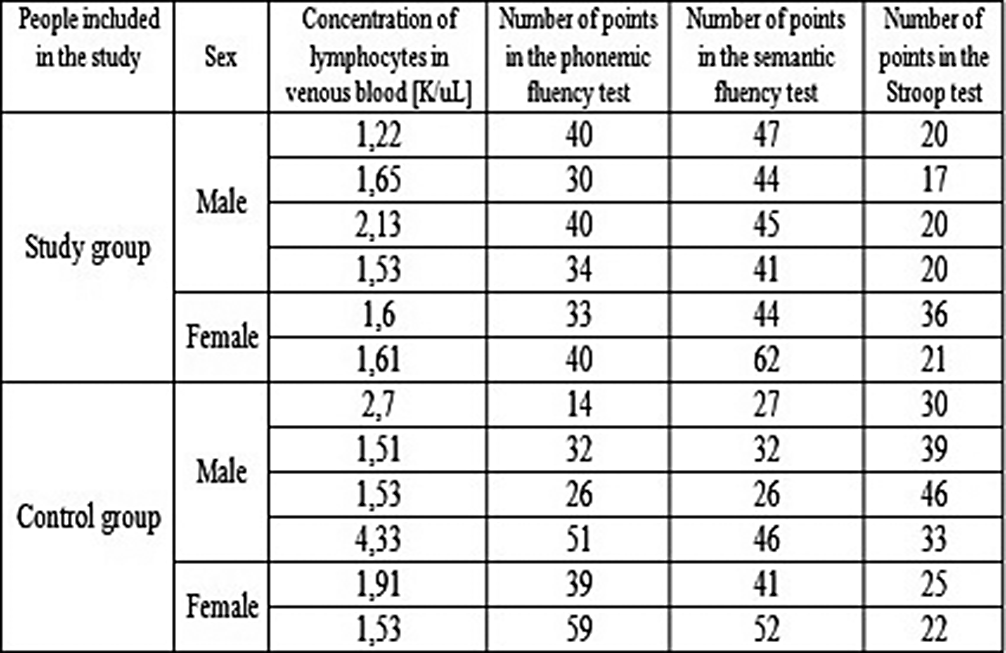e-Poster Viewing
Abstract
Baseline antipsychotic prescription and short-term outcome indicators in individuals at clinical high-risk for psychosis: Findings from an Italian longitudinal study
-
- Published online by Cambridge University Press:
- 27 August 2024, pp. S762-S763
-
- Article
-
- You have access
- Open access
- Export citation
Peculiarities of social functioning in patients with negative symptoms in schizophrenia
-
- Published online by Cambridge University Press:
- 27 August 2024, p. S763
-
- Article
-
- You have access
- Open access
- Export citation
Acute effects of intranasal ocytocin on affective empathy of patients with refractory schizophrenia and healthy controls: results of a randomized clinical trial
-
- Published online by Cambridge University Press:
- 27 August 2024, pp. S763-S764
-
- Article
-
- You have access
- Open access
- Export citation
Lymphocyte level and selected cognitive functions in patients with schizophrenia – preliminary results
-
- Published online by Cambridge University Press:
- 27 August 2024, p. S764
-
- Article
-
- You have access
- Open access
- Export citation
The SLC6A1 Mutation Schizophrenia case — A Comprehensive Case Study With iPSC Generation
-
- Published online by Cambridge University Press:
- 27 August 2024, pp. S764-S765
-
- Article
-
- You have access
- Open access
- Export citation
Short-chain fatty acids in schizophrenia: are they affected by a depressive state?
-
- Published online by Cambridge University Press:
- 27 August 2024, pp. S765-S766
-
- Article
-
- You have access
- Open access
- Export citation
Unlocking insights from actigraphy: examining feature selection and activation detection approaches for enhanced data interpretation
-
- Published online by Cambridge University Press:
- 27 August 2024, p. S766
-
- Article
-
- You have access
- Open access
- Export citation
Manic episode with psychotic symptoms in a patient with Pseudologia Fantastica of years of evolution. A case report
-
- Published online by Cambridge University Press:
- 27 August 2024, pp. S766-S767
-
- Article
-
- You have access
- Open access
- Export citation
Neurodevelopmental outcomes in children conceived by assisted reproductive treatment
-
- Published online by Cambridge University Press:
- 27 August 2024, p. S767
-
- Article
-
- You have access
- Open access
- Export citation
Do attachment styles influence the sexual function of an individual?
-
- Published online by Cambridge University Press:
- 27 August 2024, pp. S767-S768
-
- Article
-
- You have access
- Open access
- Export citation
Breaking the Taboo: Unveiling the Prevalence and Predictors of Female Sexual Dysfunction in Tunisia
-
- Published online by Cambridge University Press:
- 27 August 2024, p. S768
-
- Article
-
- You have access
- Open access
- Export citation
Relationship between sleep and sexual functioning in Indian females
-
- Published online by Cambridge University Press:
- 27 August 2024, pp. S768-S769
-
- Article
-
- You have access
- Open access
- Export citation
The Impact of Psychotropics on Sexuality: A Literature Review
-
- Published online by Cambridge University Press:
- 27 August 2024, p. S769
-
- Article
-
- You have access
- Open access
- Export citation
Perspectives on Sexual Health Management among Tunisian Primary Care Physicians
-
- Published online by Cambridge University Press:
- 27 August 2024, p. S769
-
- Article
-
- You have access
- Open access
- Export citation
Knowledge, perceptions and attitudes of medical doctors toward elderly sexuality in Tunisia
-
- Published online by Cambridge University Press:
- 27 August 2024, pp. S769-S770
-
- Article
-
- You have access
- Open access
- Export citation
Beyond Rest: Exploring the Sleep-Exercise Connection
-
- Published online by Cambridge University Press:
- 27 August 2024, p. S770
-
- Article
-
- You have access
- Open access
- Export citation
Sleeping Problems or Emerging Psychosis? A Review of Emerging Literature
-
- Published online by Cambridge University Press:
- 27 August 2024, pp. S770-S771
-
- Article
-
- You have access
- Open access
- Export citation
Exploring the Interplay Between Psychosis and Sleep Disruption: Insights into Course, Insomnia, Nightmares, and Treatment
-
- Published online by Cambridge University Press:
- 27 August 2024, p. S771
-
- Article
-
- You have access
- Open access
- Export citation
The Nexus of Sleep Disorders and Violence in Patients with Schizophrenia: What do the Data Say?
-
- Published online by Cambridge University Press:
- 27 August 2024, pp. S771-S772
-
- Article
-
- You have access
- Open access
- Export citation
The impact of sleep deprivation on symptoms of anxiety, depression, stress and on the quality of life in medical staff
-
- Published online by Cambridge University Press:
- 27 August 2024, p. S772
-
- Article
-
- You have access
- Open access
- Export citation



